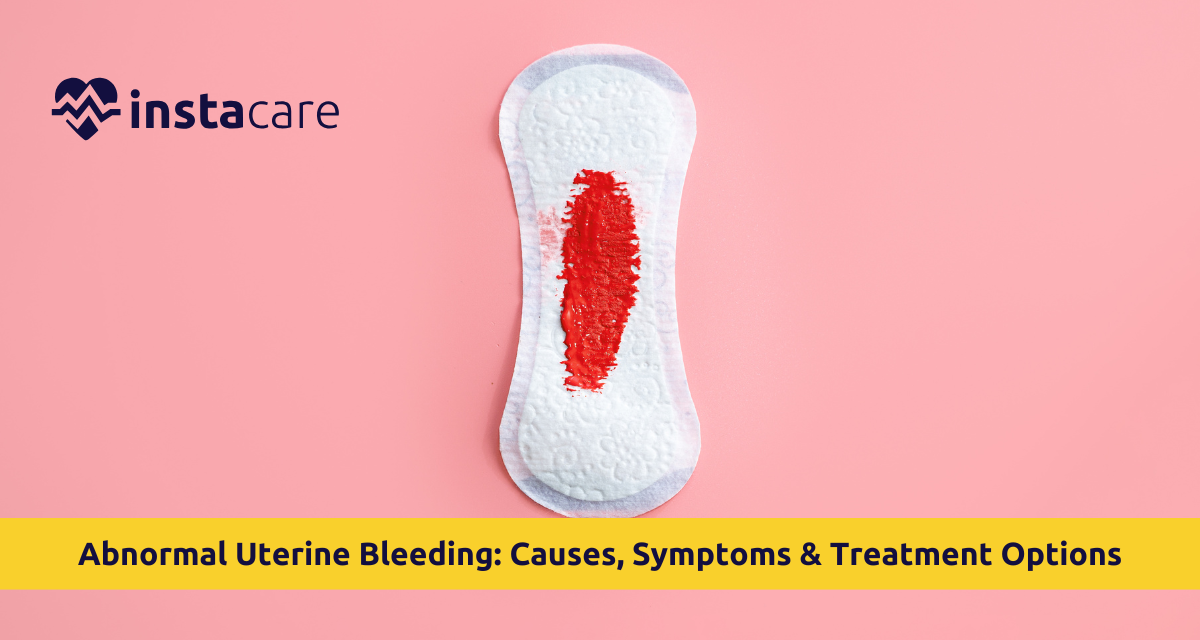Any variation from normal menstrual interval, length, or volume in a woman is known as abnormal uterine bleeding (AUB). Severe and prolonged menstrual discharge, intramenstrual, or postmenopausal bleeding, AUB is painful and distressing. AUB always indicates an intrauterine condition of menstruation and must be explored accordingly by relevant gynecological evaluation. Learning about causes of abnormal uterine bleeding, the identification of signs, and receiving all treatment is the basis for healthy care of your reproductive system.
What Is Abnormal Uterine Bleeding?
Abnormal uterine bleeding is any bleeding within the uterus outside a regular menstrual period. It is bleeding other than at normal times, more than usual duration, or excess discharge. It includes:
- irregular periods bleeding (too heavy or too light)
- Heavy menstrual bleeding
- bleeding after menopause
- Spotting between menstrual periods
It may be seen in all age groups of women ranging from adolescent girls to perimenopausal women with uterine bleeding. AUB may have many reasons ranging from hormonal imbalance bleeding to structural causes such as uterine fibroids and bleeding.
Common Causes of Abnormal Uterine Bleeding
Evidence of AUB etiology assists in the choice of proper management and averting complications. Amongst the most common causes are:
Hormonal Imbalance
One of the most common etiologies of AUB, particularly in women within menopausal and adolescent ages. Bleeding due to hormonal imbalance leads to the occurrence of an endogenous or exogenous mismatching of estrogen and progesterone that disrupts the menstrual cycle.
Uterine Fibroids
Benign fibromas of the uterus that can cause menorrhagia, cramping, and intermenstrual spotting. The connection between uterine fibroids and bleeding is self-evident and may have to be relieved by surgery.
Endometrial Hyperplasia
The endometrium is thickened, typically secondary to overproduction of estrogen. It can cause erratic menstruation or postmenopausal bleeding. It can culminate in risk of cancer of the uterus if left untreated.
Dysfunctional Uterine Bleeding (DUB)
Diagnosis if no systemic or structural cause is present. DUB also presents with hormonal imbalance and more frequently in young women and perimenopausal women.
Polyps and Adenomyosis
They are benign tumors and disease of the uterus and are associated with irregular bleeding patterns.
Drugs or Bleeding Disorders
Drug (e.g., anticoagulants) and blood clotting menstrual disorders may also be a cause of unexplained uterine bleeding. It won't diagnose and make the correct decisions at the right time if someone is aware of the aetiology of abnormal uterine bleeding.
Symptoms of Abnormal Uterine Bleeding
Symptoms of abnormal uterine bleeding are highly heterogeneous but are likely to be:
- Heavy menstruation (hourly changing tampons/pads)
- Irregular menstrual cycles (less than 21 days or more than 35 days)
- Spotting between periods
- Heavy menstruation (lasting more than 7 days)
- Postmenopausal bleeding
- Anemia or drowsiness due to abnormally heavy menstrual loss
These symptoms interfere with normal activity, elicit emotional distress, and even cause severe medical diseases. Menstrual cycle alterations thus necessitate a visit to a gynecologist for an appropriate gynecological examination.
How Is AUB Diagnosed?
Unnecessary abnormal bleeding is diagnosed by the integration of medical history, physical exam, and laboratory tests. That is what a medical doctor does:
Medical History
Family history of previous menstrual cycle, pregnancy, use of birth control, and family history of disease of the menstrual system are absolute must-get facts.
Physical & Pelvic Exam
Physical and pelvic examination screens for abnormalities of the reproductive organs.
Blood Tests
To eliminate anemia, thyroid, or blood clotting disease.
Ultrasound
A pelvic ultrasound will be able to detect fibroids, polyps, and endometrial thickening.
Endometrial Biopsy
It is particularly performed in postmenopausal bleeding or in suspected endometrial hyperplasia. Performed to pick up a sample of the lining of the uterus for any abnormality.
Hysteroscopy
Placement of a telescope within the uterus to further explore within. Early and proper abnormal bleeding diagnosis results in a better result of the treatment for abnormal uterine bleeding as well as avoids probable complications.
Treatment of Abnormal Uterine Bleeding
Successful management of abnormal uterine bleeding varies with age, family planning, etiology, and significance of the symptoms. All are intended to interrupt or diminish the bleeding, correct hormonal function, and restore structural order.
Hormonal Treatments
These are often the first line of treatment. Combination oral contraceptives also treat excessive menstrual bleeding, regularize abnormal menstruation, and for pain control. For bleeding due to hormonal imbalance, cyclic progesterone therapy will regularize uterine lining and enhance balance.
Hormonal intrauterine devices such as Mirena are very effective in dysfunctional uterine bleeding and endometrial hyperplasia. These will decrease bleeding, and in a few, will abolish menstruation altogether.
Non-Hormonal Drugs
These medications are best suited for women who can't or don't want to take hormones. NSAIDs like ibuprofen or naproxen cut off inflammation and cut off blood flow with menstruation. Tranexamic acid is a prescription non-hormonal drug that causes clotting and will regulate menstrual bleeding.
Surgical Options
In the case of failure of one's medical care or intolerance, surgery may be possible:
- Myomectomy is also the first treatment of choice if fibroids and uterine bleeding are producing palpable symptoms but still fertility is to be desired.
- Endometrial ablation is also another less destructive procedure on the uterine lining. It's ideal for those who never plan to conceive again in life.
- The most serious is hysterectomy or removal of the uterus. It is usually reserved for treatment-resistant AUB that cannot be managed by other therapy or for potentially life-threatening disease such as endometrial hyperplasia that cannot or will worsen with other treatment.
Treatment of Menstrual Disorders and Perimenopause
Therapies for uterine bleeding in perimenopause must consider hormonal transition, increased susceptibility to endometrial disease, and lifestyle in the patient. There is the potential for calming abnormal cycles early in either case and preventing potential future issues from taking root. Therapy for the etiology of menstrual sickness is most critical in either instance. Proper gynecologic assessment ensures that treatment, medical or surgical, is in progress.
Conclusion
Abnormal uterine bleeding is underdiagnosed but common in women of any age. From menopausal bleeding and intermenstrual spotting to an abnormal menstrual cycle, AUB can hide pathology such as hormonal imbalance bleeding, bleeding and fibroids, or even endometrial hyperplasia.
Diagnosis of abnormal bleeding needs to be treated by a check-up gynecology. Proper diagnosis enables right treatment of abnormal uterine bleeding, ranging from medication to surgery, to restore menstrual normalcy and quality of life. Proper identification of abnormal uterine bleeding symptoms and medical treatment at the right time provides the best outcome.
Please book an appointment with the
best Gynecologist in Lahore, Karachi, Islamabad, and all major cities of Pakistan through
InstaCare, or call our helpline at 03171777509 to find a verified doctor for your disease.

